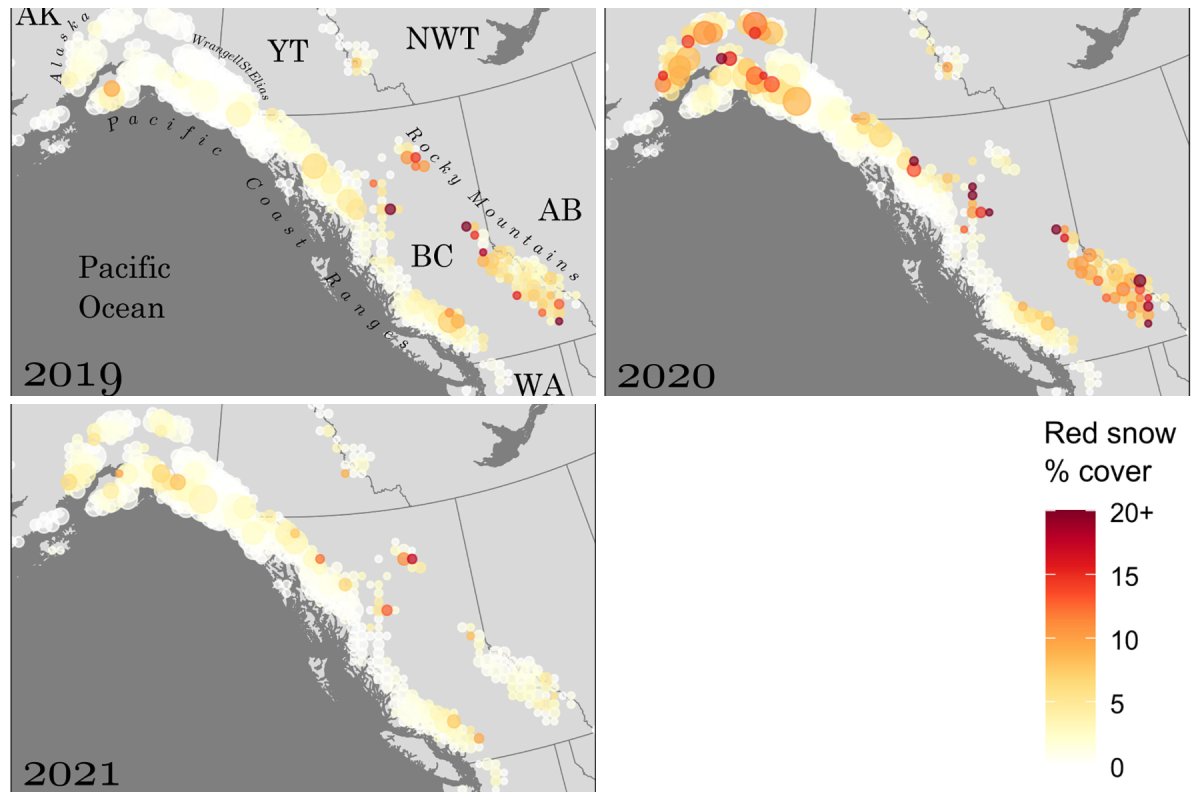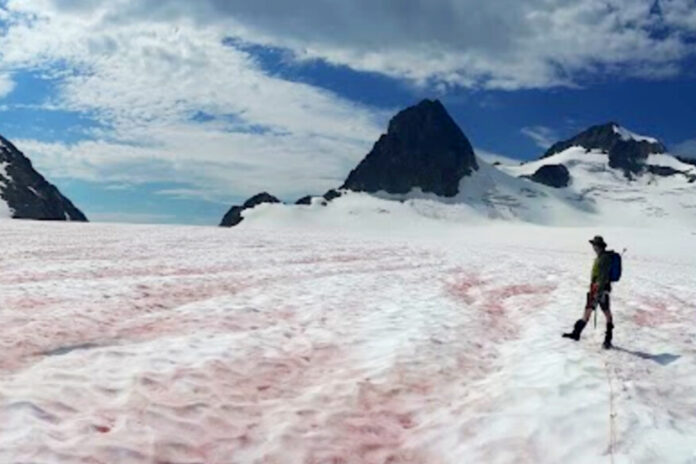Snow is turning red across Alaska and much of Canada’s Rocky Mountains, threatening the future of the frozen glaciers.
This “watermelon snow,” also known as “glacier blood,” is caused by the blooming of a type of pink-colored algae called Chlamydomonas nivalis, which flourishes in freezing temperatures.
This pink coloring makes glaciers much more prone to melting as the colored algae cause sunlight to be absorbed rather than reflected, heating the surrounding ice.
A recent study in the journal Science Advances found that this watermelon snow has now crept across 5 percent of the total glacier area in northwestern North America, including mountains in Alberta, British Columbia, Alaska, Idaho, Montana and Washington State.
Engstrom and Quarmby. Sci. Adv. DOI:10.1126/sciadv.adi3268
Some individual glaciers saw up to 65 percent of their area covered in the pink algae during a single season, which the study estimates caused as much melting as a 3-centimeter (1.2-inch) average meltwater equivalent across the surface of the glacier.
“Red snow was extensive on many North American glaciers and icefields. On heavily affected glaciers, bloom-albedo contributed substantially to total summer snowmelt,” the authors wrote in the paper.
The researchers made these discoveries using thousands of satellite images taken between 2019 and 2022 and determined that the watermelon snow was having a significant impact on the rate of melting of glaciers. The algae was present on 4,552 of the 8,700 glaciers studied.
“The red pigment means that when they bloom, they give the snow this red hue. It gets called watermelon snow because it looks like the color of watermelon,” Lynne Quarmby, paper co-author and professor of molecular biology and biochemistry at Simon Fraser University, told Canada’s CBC.
However, the impact that the algae is having on the glaciers and snowpack is mild in comparison to the effects of climate change and global warming. In fact, the glaciers are melting so much due to climate change that these algae are disappearing altogether.
“We set out on this study to look at the impact of climate change on these blooms and their impact on climate change,” said Quarmby. “And I think the impact of climate change on them is clear and dramatic.”

Engstrom and Quarmby. Sci. Adv. DOI:10.1126/sciadv.adi3268
In 2020, the glaciers along the coast of the Pacific Northwest began to melt early in the spring due to abnormally high temperatures, meaning that in some locations, the algal blooms never developed at all.
“We don’t really need any more canaries in this mine, but they’re yet another canary in the mine,” said Quarmby. “Losing the algae is just an indicator that we’re losing snowpack and glaciers, and these will impact our lives and the lives of lots of other organisms.”
These algae, despite acting as heat sinks on the glaciers, also absorb CO2 from the atmosphere during photosynthesis.
“For me, it’s one more little sadness that we’re losing it. If you see these things under the microscope, they’re spectacular. Even if you see them just on the landscape, it’s awe-inspiring,” Quarmby said.
As glaciers shrink further, the melting effect of the remaining watermelon snow algae may be even more damaging to the ice and snow.
“As the snowpack dwindles, these blooms are going to become increasingly concentrated and smaller and smaller,” Scott Hotaling, a Utah State University ecologist, told CBC.
“The melting characteristics of that snow algae are going to become increasingly important. When there’s only a small amount of snow left, anything that affects that matters more.”
Do you have a tip on a science story that Newsweek should be covering? Do you have a question about watermelon snow? Let us know via [email protected].


